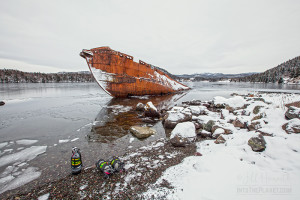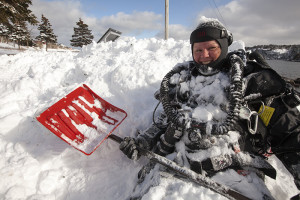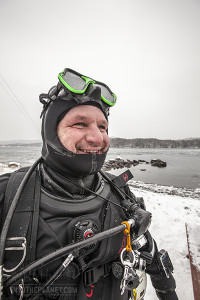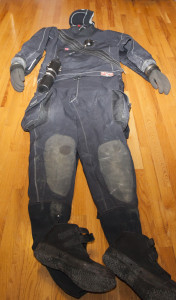 Making documentary films while immersed in the hostile, yet stunning waters of the Canadian Arctic, I need great technology to keep me warm and safe. The travel, dives, and image making all create their own set of unique challenges, and once you are in the north, there is no way to call up a dive shop for something you may have forgotten. I’ve spent many months in the polar region, most recently helping to create a film about climate change. Camping on the sea ice and then on a remote island outpost, I swam with polar bears, hovered below fighting walrus and stepped delicately on the bitter edge of the disintegrating ice floe. As a result of my experiences, I have developed a list of tips that will help anyone who chooses to dive in cold water.
Making documentary films while immersed in the hostile, yet stunning waters of the Canadian Arctic, I need great technology to keep me warm and safe. The travel, dives, and image making all create their own set of unique challenges, and once you are in the north, there is no way to call up a dive shop for something you may have forgotten. I’ve spent many months in the polar region, most recently helping to create a film about climate change. Camping on the sea ice and then on a remote island outpost, I swam with polar bears, hovered below fighting walrus and stepped delicately on the bitter edge of the disintegrating ice floe. As a result of my experiences, I have developed a list of tips that will help anyone who chooses to dive in cold water.
1. Staying Warm Starts in the Cook Tent
Maintaining warmth starts with proper hydration and great nutrition. Never hold back on drinking just because you are reluctant to take a pee in the wild. Eat well and don’t be afraid of high-fat food. For me, a high protein, high fat, and lower carb diet serves me well in the cold environment.
2. Technical Clothes are Critical
Layer up with professionally designed technical clothing. Leave anything cotton at home and swap it for merino wool base layers or engineered undergarments such as the Fourth Element J2 base layer. (Links to some recommended products follow this article.) Take your base layers off and dry them every night. Bring a second set of base clothing for sleeping. Pack some string to make a clothesline in your tent, cabin or hotel room.
3. A Big Set of Boots to Fill
In the high Arctic, we always wear insulated rubber boots. I need to buy boots that are two sizes larger than my normal shoes to accommodate layers of pure wool socks. A wool-felt liner provides insulation and can be removed and dried at every opportunity. Dampness equals cold. Rubber boots also make wet boat entries possible. These boots are excellent for slipping easily on and off your feet. It makes dressing in your dry suit possible without getting your socks wet. Slip-off boots make the transition to a tent or hotel room tidier too.
4. Top It Off
Every layer of your outerwear should be technical, roomy, waterproof and breathable. Despite popular belief it rains in the polar realms. With global climate change it rains a lot more in the summer, but you don’t have to be in the Arctic, you can get cold and wet on a New Jersey dive boat too. When you buy your outerwear, think in layers and consider that you might want to wear something over your dry suit, or over your dry suit opened to the waist. You might want a big coat that gives you enough cover to get changed in public. The SurfFur Jacket or Fourth Element Storm Poncho are great.
5. The Dry Suit
You are only one suit flood away from a real emergency in freezing water so buy a dry suit that is reliable. Get a leak test if it is old and then check the dump valve and suit inflation valve to ensure they are fully tightened against the suit fabric before diving. Check the inflator nipple to verify that it is not slowly unscrewing itself. Take a close look at the seals. If the latex rubber feels sticky, it will soon tear at the most inopportune time. Test the zipper and lubricate it as directed by the manufacturer.
6. Under It All
 Suit undergarments should be technical. They should provide warmth even if the suit floods. A cotton tracksuit just won’t cut it. The undergarments need have the loft to trap warm air, so if your suit got tight from holiday binge eating, you will be cold. Incompressible undergarments such as the Fourth Element Halo 3D or the undergarments found in the Waterproof D1 Hybrid Drysuit are extremely warm. The Fourth Element X-Core vest is also a stellar heat trapper. You can also choose to go electric. The Santi BZ400 heated suit, vest, or gloves are life-changing. You should save the heat for decompression or later in the dive. A diver who starts hot and ends a dive cold can exponentially increase their likelihood of DCI. I use a Light Monkey battery pack with Pitkin controller that enables a variety of heat levels. Never buy heated garments that are not intended for diving. A motorcycle vest, gloves or heated socks might be water resistant but can shock, electrocute or burn you in a flooded dry suit. A motocross enthusiast friend of mine unfortunately proved this point a few years back.
Suit undergarments should be technical. They should provide warmth even if the suit floods. A cotton tracksuit just won’t cut it. The undergarments need have the loft to trap warm air, so if your suit got tight from holiday binge eating, you will be cold. Incompressible undergarments such as the Fourth Element Halo 3D or the undergarments found in the Waterproof D1 Hybrid Drysuit are extremely warm. The Fourth Element X-Core vest is also a stellar heat trapper. You can also choose to go electric. The Santi BZ400 heated suit, vest, or gloves are life-changing. You should save the heat for decompression or later in the dive. A diver who starts hot and ends a dive cold can exponentially increase their likelihood of DCI. I use a Light Monkey battery pack with Pitkin controller that enables a variety of heat levels. Never buy heated garments that are not intended for diving. A motorcycle vest, gloves or heated socks might be water resistant but can shock, electrocute or burn you in a flooded dry suit. A motocross enthusiast friend of mine unfortunately proved this point a few years back.
7. Hand’s Down Winners
There are so many choices in hand protection that it is tough to know what to buy. Wet gloves are not as bad as you might think. In this case, I use a pair of thin 1mm neoprene gloves. I turn them inside out so that the rubber side is against my skin and the suit’s wrist seal. These gloves should be form fitting. Wear these when getting dressed. At the last moment, don 7mm neoprene gauntlet-style, three-finger mitts. The gauntlets should cover the entire wrist seal. You will be surprised that you still have reasonable dexterity. The risk of a suit flood is further reduced through protection of the wrist seals.
If you choose dry gloves, there are a lot of options. Use quality under gloves and bring several sets since they will get damp when dressing and undressing. Polypro, merino wool or thin neoprene under gloves work well. I will not use a dry glove system that does not have a wrist seal back up. It is far too easy to suffer a complete suit flood if the glove leaks or pops off. Test out the ring system for security, ease of donning and ease of removal. You need to know if you will require help getting your gloves on or off.
8. The Heads Up
Your dive hood is essential for warmth. Wear two if you are still cold. I like a smooth, snug hood inside and the second hood on top. Make sure they both have vent holes to be rid bubbles. Use the space in-between the two hoods as handy storage for small flat items such as cave dive line arrows or even a tiny bottle of defog or a spare O-ring kit in a ziplock bag. Stuff a warm hat and gloves inside the chest of your dry suit, so they are immediately available to put on your wet head when you unzip after a dive.
9. The Life Support
Regulator free-flows are a significant hazard when diving under ice or in frigid water. The sudden drop in pressure causes an unstable condition as air passes from the cylinder to the regulator first stage. When high pressure air passes through the first stage, it hyper-cools the metal moving parts. In a piston reg, small ice crystals can block the piston, causing more air flow and trapping the piston open. The air pressure overwhelms the downstream valve in the second stage causing a free flow and in some cases, hose rupture. To minimize the chance of this happening, use regulators conforming to Euro standard EN250 (Cold Water Use). Diaphragm regs are often better than pistons. Diaphragms can also be fitted with cold water kits, reducing the cold water contact with moving metal parts.
Rebreather diving is warmer than open circuit diving because the air you breathe from a scuba tank is the same temperature as the surrounding water. However, rebreather divers benefit from the exothermic reaction that takes place in the scrubber canister. The gas they breathe is warm and moist from the adsorption of carbon dioxide.
 10. It’s all in the Technique
10. It’s all in the Technique
Free flows can also occur at the second stage, usually caused by extremely low air temps and breathing a wet reg in the open air. To prevent this, never breathe on any second stage out of the water. To begin your dive, inhale topside, then dip your head below water and exhale into the second stage. Do this two or three times to warm the second stage and then submerge and begin breathing in a controlled manner. Once you are underwater, prevent hyper-cooling of the first stage through high volume gas transfers. Never inflate a dry suit or BCD and breathe simultaneously. To decrease the volume of gas passing through the first stage, do these things independently.
11. Before You Jump
Ensure that the cylinder and the air within it are as dry as possible. Reputable air filling stations should have dry clean air, but if you are filling, make sure the valve is dry before hooking up the fill whip. Between dives, ensure that no water enters the air intake of the first stage when drying the dust cap.
12. Bits and Pieces
There are a lot of accessories that can make your diving experience more comfortable. The Aqua Lung lip shield insulates your lips. Heat Factory hand warmers are beneficial after dives but don’t put these inside a suit since the higher PO2 make them burn hotter and faster causing injury. Rechargeable hand warmer/power banks are also great after diving. You can pop one under your hat or in your gloves and after the dive it can charge your cell phone too.
 13. Record Your Adventure
13. Record Your Adventure
You might not have too many cold water dives in your life, so make sure you get it all recorded on video. I use the Paralenz dive camera. Many camera batteries are not designed for use in cold weather. As great as a smart phone shoots, once it gets too cold, it shuts off. That’s why I choose the Paralenz. It recharges quickly and stays charged in the cold, offering me about two hours of runtime shooting 4K video. By using the high-resolution video, screen captures are gorgeous. Depth controlled color correction eliminates a lot of handling, and the good news is that the controls on the camera are big and chunky and can be operated easily with either wet or dry gloves. Tactile feedback is provided with a series of buzzing vibrations, letting the diver know they have triggered or turned off recording or moved into any number of other settings. When I wear it on a helmet, I can reach up, pull the trigger, feel the buzz and know it is shooting without even looking.
Finally, if you are interested in cold water diving, consider taking an ice diving program. Whether you ever intend to dive under the ice again or not, the technical aspects of dealing with the cold will serve you well in the future.
If you are interested in any of the products in this article, they can be found below:
Paralenz Dive Camera – Link: https://amzn.to/2CFr2JI
Fourth Element J2 Base Layer – Link: https://amzn.to/2x0UTXL
Insulated Rubber Boots – Link: https://amzn.to/2oX9AGE
The SurfFur Jacket – Link: https://amzn.to/2NpMVkv
Fourth Element Halo 3D – Link: https://fourthelement.com/halo3d/
Waterproof D1 Hybrid Drysuit – Link: https://amzn.to/2NpNWJl
Fourth Element X-Core Vest – Link: https://fourthelement.com/x-core/
Santi BZ400 Heated Suit – Link: https://santidiving.com/bz400-extreme-heated,544,en
Light Monkey Heat Packs – Link: http://www.lightmonkey.us/heater-packs
Aqua Lung Lip Shield – Link: https://www.diverightinscuba.com/lip-shield.html
Heat Factory Hand Warmers – Link: https://amzn.to/2x5eIwq
